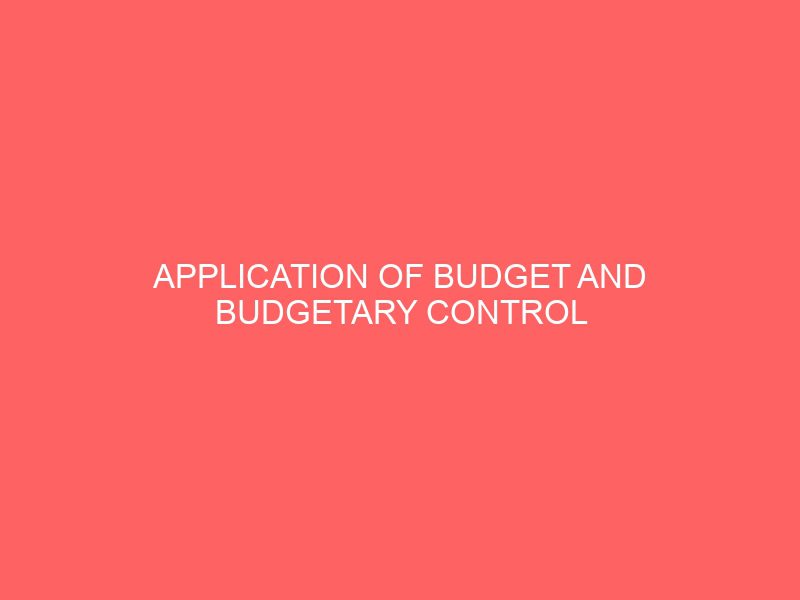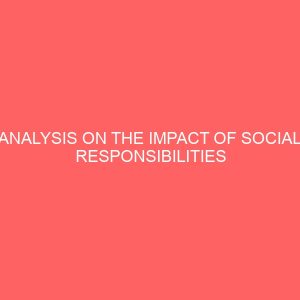Description
CHAPTER ONE
1.0 INTRODUCTION
This project is on Application of budget and budgetary control measures in a non profit organization a study of catholic church, Lagos. Budgeting has come to be accepted as an efficient method of short-term planning and control. It is employed, no doubt, in large business houses, but even the small businesses are using it at least in some informal manner. Through the budgets, a business wants to know clearly as to what it proposes to do during an accounting period or a part thereof. The technique of budgeting is an important application of Management Accounting. Probably, the greatest aid to good management that has ever been devised is the use of budgets and budgetary control. It is a versatile tool and has helped managers cope with many problems including inflation.
The Chartered Institute of Management Accountants, England, defines a ‘budget’ as under: ” A financial and/or quantitative statement, prepared and approved prior to define period of time, of the policy to be persued during that period for the purpose of attaining a given objective.” According to Brown and Howard of Management Accountant “a budget is a predetermined statement of managerial policy during the given period which provides a standard for comparison with the results actually achieved.”
Budgetary Control is the process of establishment of budgets relating to various activities and comparing the budgeted figures with the actual performance for arriving at deviations, if any. Accordingly, there cannot be budgetary control without budgets. Budgetary Control is a system which uses budgets as a means of planning and controlling.
According to I.C.M.A. England Budgetary control is defined by Terminology as the establishment of budgets relating to the responsibilities of executives to the requirements of a policy and the continuous comparison of actual with the budgeted results, either to secure by individual actions the objectives of that policy or to provide a basis for its revision.
A non-profit organization is a group organized for purposes other than generating profit and in which no part of the organization’s income is distributed to its members, directors, or officers. Non-profit corporations are often termed “non-stock corporations.” They can take the form of a corporation, an individual enterprise (for example, individual charitable contributions), unincorporated association, partnership, foundation (distinguished by its endowment by a founder, it takes the form of a trusteeship), or condominium (joint ownership of common areas by owners of adjacent individual units incorporated under state condominium acts). Non-profit organizations must be designated as nonprofit when created and may only pursue purposes permitted by statutes for non-profit organizations. Non-profit organizations include churches, public schools, public charities, public clinics and hospitals, political organizations, legal aid societies, volunteer services organizations, labor unions, professional associations, research institutes, museums, and some governmental agencies.
Non-profit entities are organized under state law. For non-profit corporations, some states have adopted the Revised Model Non-Profit Corporation Act (1986). For non-profit associations, a few states have adopted the Uniform Unincorporated Non-Profit Association Act (See Colorado 7-30-101 to 7-30-119). Some states exempt non-profit organizations from state tax and state employment programs such as unemployment compensation contribution. Some states give non-profit organizations immunity from tort liability (see Massachusetts law giving immunity to a narrow group of non-profit organizations) and other states limit tort liability by enacting a damage cap. State law also governs solicitation privileges and accreditations requirements such as licenses and permits. Each state defines non-profit differently. Some states make distinctions between organizations not operated for profit without charitable goals (like a sports or professional association) and charitable associations in order to determine what legal privileges the respective organizations will be given.
Some NPOs may also be a charity or service organization; they may be organized as a nonprofit corporation or as a trust, a cooperative, or they exist informally. A very similar type of organization termed a supporting organization operates like a foundation, but they are more complicated to administer, hold more favorable tax status and are restricted in the public charities they support. Their mole is not to be successful in terms of wealth, but in terms of giving value to the groups of people they administer to.
1.1 BACKGROUND OF THE RESEARCH
There is hardly any aspect of human Endeavour that does not have economic implication because economics as a science is essentially concerned with the study of scarce resources, there allocation, management and utilization. This reality is what gave birth to a business budget in the 20th century. The term budget was first put to use in Europe to refer to first, a leather bag used to carry statement of revenue and expenditure, and later the term was referred to as the statement itself and not just the container.
Today, a budget play a greater role in the planning and control process of basically all organization, be it private or public sector, ministries and non profit-making organizations.
Organizations developed plans on how to go about its future operations. While control measures are used to correct any deviation from the plans. The budgetary process is an integral part of both planning and control. Budgeting is making plans for the future, implementing those plans and monitoring activities to see whether they conform to plans. To do this successfully, it requires maximum commitment by the top management, corporative and motivated middle management and staff, and well organized reporting system.
The importance of budget to households, business organization can never be over emphasized. Most families or members of households have at point developed a budget to guide them in allocating resources over a specific period of time. The family budget is a planning tool, but it also serve as control behaviour of family members by setting limits on what can be spent within each budget category. Budget enables house to know how much of their money is being spent. Such a situation can easily lead family into unexpected debt and severe financial difficulties.
Likewise, budgets play a similar planning and control role for managers within business units and budgets are a central part of a design and operation of management accounting system. As in household budget, budget in business organizations reflects in quantitative term, how to allocate financial and other resources to each organizational subunit, based on its planned activity objective. Budgeting activity to organizational unit can reflect how well unit managers understand the organizational and provides an opportunity for the organization’s top planners to correct misperceptions about the organization’s goal. Budgeting also aims at coordinating the organization’s many activities. For example, budget show the effect of sales level or volume on purchasing, production, administrative activities etc.
In reality, budgeting is the most widely used accounting tool for planning and controlling the activities of organizations. Budgeting system helps managers to forecast. By looking into the future and planning managers are able to anticipate and correct potential problems before they arise. Managers can then focus on exploiting opportunities instead of fighting fires as one observer said ‘‘few businesses plan to fail, but many of those that flop fail to plan’’ (Horngren, et al, 2002; 178).
The research is deeply concerned with the extent to which management of Brewery companies seize the advantages associated with budgeting process. The researcher is interested in finding out if managers of Brewery companies effectively and efficiently design and implement realistic budgets. Do they use budgets as a potent tool for resource allocation and control?
The choice of Catholic Church as a case study for this research work is informed by the industry’s relatively long-life span of production. Secondly, the relative low level of production at the industry has also prompted the researcher to investigate its budgetary system.
1.2 STATEMENT OF RESEARCH PROBLEM
Budgeting and budgetary control is one of the essential functions of every organization (business, Nonprofit or governmental). Survival and growth of any corporate organization depends on effective budgetary control measures. This implies that if budgets are effectively designed and implemented, an organization can achieve massive results.
On the other hand, in Nigeria today, there are incidences of corporate failure in most organizations. It appears managers are not taking advantage of the budgetary process to the success of the organizations.
The behavioral or human aspect of budgeting is equally worrisome; how do people’s attitudes affect the budgets, and in turn, how do budget affect people’s behaviour? The questions intrigued social scientist to engage in extensive study about the human factors involved in budgeting.
Moreover, the research is aimed at knowing if budgeting and budgetary control is playing a significant role in controlling measure in the organization, to investigate the problems associated with the designing and implementation of budgets in organization, to find out whether poor performance and low productivity and development in some of the NPO is attributed to poor implementation and finally, to investigate the human aspect of budgeting.
1.3 OBJECTIVES OF THE STUDY
The main focal point and idea of this research work is centered on the research title which is to ascertain the application of budget and budgetary control measures in Catholic Church Lagos dioceses. Other objective the research will cover in this work are:
- To ascertain how financial budget affects priests recruitment in the Catholic Church.
- To investigate on how Catholic Church Lagos manages their issues of variance which have to do with budgeting control
- To access the applicability of budgets and budgetary control in the Catholic Church Lagos.
- To highlight the possible ways the Catholic Church can improve their control measure with the use of budgets and budgetary control system.
1.4 SIGNIFICANCE OF THE STUDY
The study will be significant in various ways to various parties, as will be seen below;
- It will present in a precise manner, the importance of the role of budgeting and budgetary control measures in an organizational.
- To managers and potential managers, the findings of the research, suggestion and recommendations based on the findings will be a good guide for future management of resources using budgeting and budgetary control. The outcome of the study will help widen their horizons on resource allocation and control.
- The research report will also serve as a reference material to students of accounting, especially those with a bias in management accounting.
- The research will also provide ample information to external auditors on how resources of organization should be allocated and managed as a NPO. This will certainly enhance their audit planning.
- The research will also be beneficial to the researcher. This is because the study will expose the researcher to so many related areas in the course of carrying out his research. This will enhance the researcher’s experience, knowledge and understanding of fault tolerant broadcasting and gossiping in communication network.
- Finally, this study is intended to unveil those factors that are responsible for poor budget implementation frequently leading to their failures while also highlighting the control mechanisms required for a successful budget implementation.
1.5 RESEARCH QUESTION
For a better understanding and comprehension of this research work the researcher went on asking some important question which formed the research question for this study, which will be addressed and answered, questions are.
- How do financial budget affects priests recruitment
- How do the Catholic Church manage their issues of variance which have to do with budgeting control?
- What is the applicability of budgets and budgetary control in a Catholic Church?
- What are the means of improving Catholic Church control measure with the use of budgets and budgetary Control?
1.6 RESEARCH HYPOTHESIS
The researcher formed some of the hypothesis which will be tested for the support of the study which will enable the readers and the researcher know the stand of this research work. The research hypothesis are as follows.
Ho1: There is no relationship between budget and budgetary control in organization control measures
Hu1: There is a relationship between budget and budgetary control in organization control measures
Ho2: There is no relationship between the design and the implementation of Budgets in organizational control measures
Hu2: There is relationship between the design and the implementation of budgets in organizational control measures
Ho3: There is no significant importance to the implementation of budgetary control in an organization.
Hu3: There is significant importance to the implementation of budgetary control in an organization.
1.7 SCOPE OF THE STUDY
The research is intended to cover budgetary activities as they affect the organization control measures and productivity of the Catholic Church. However, due to the diverse nature of the Catholic Church with varying objectives and the time frame required for the report of the research , the research has been scaled down to a case study of Catholic Church Lagos-Ikeja. The period under investigation is from 2009-2015
1.8 LIMITATION OF THE STUDY
During the course of performing/researching this project work, the researcher encountered a lot of challenges as well as opposition which ranges from financial constraints, time factor, sourcing of material etc. this factors in their own ways, slowed down the speedy progress of this work that resulted to the researcher not being able to finish the research work on time as is required
1.9 DEFINITION OF TERMS
NONPROFIT ORGANIZATION: A nonprofit organization or organization (NPO, also known as a non-business entity) is an organization that uses its surplus revenues to further achieve its purpose or mission, rather than distributing its surplus income to the organization’s shareholders.
1.10 STRUCTURE OF THE STUDY
This research work is divided into five (5) chapters with chapter one as the introductory chapter which is divided into nine (9) sections including background to the study, statement of problem, objective of the study, the research questions, research hypotheses, significance of the study, scope of the study, the structure of the study and the definition of terms.
Chapter two is the literature review which includes the conceptual framework of budgeting and budgetary control, review of prior studies, chapter summary and a brief historical background of the case study which is Catholic Church Lagos-Ikeja.
Chapter three (3) is the research methodology made up of the introduction, research design, population and sample size, nature and sources of data, instrument and procedure for data collection, description of variables employed, techniques of data processing and analysis, problem and limitation of data collection and design and chapter summary.
Chapter four is the data analysis and result which is made up of introduction, data presentation and analysis, test of research hypotheses, evaluation of data and research findings.
Finally, chapter five (5) is the summary, conclusions, recommendations which is made up of summary of findings, generalization of findings, limitation of study, conclusions, recommendations of study and lastly the suggestions for further research.








Reviews
There are no reviews yet.